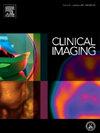Performance assessment of an artificial intelligence algorithm for opportunistic screening of abdominal aortic aneurysms
IF 1.5
4区 医学
Q3 RADIOLOGY, NUCLEAR MEDICINE & MEDICAL IMAGING
引用次数: 0
Abstract
Purpose
Abdominal aortic aneurysm (AAA) is a common incidental finding on CT imaging performed in the acute care setting. Artificial intelligence (AI) algorithms have been developed to automatically measure aortic lumen size and thus facilitate AAA detection. However, few studies have evaluated the performance of such tools in a large clinical setting. This retrospective study aimed to evaluate the performance of a commercially-available AI algorithm for the opportunistic screening of incidental AAA on non-optimized CT imaging.
Methods
CT examinations of the abdomen and pelvis performed in the emergency setting of a tertiary academic center between July 2020 and May 2021 were retrospectively processed by the AI algorithm, while natural language processing software (NLP) was used to analyze the initial radiology report. Exams which were positive for the presence of AAA on imaging by AI analysis, but negative by NLP of their corresponding report, were designated as potential discrepancies and independently reviewed by an ED radiologist.
Results
4023 abdominal and pelvic CT examinations were analyzed. 98.3 % (3955) cases were negative for presence of AAA by NLP assessment of their respective report, with 16 of these cases flagged by AI as discrepancies potentially positive for AAA. 31 % (5/16) of these cases were determined by secondary review to be truly positive for previously undocumented AAA. The enhanced detection rate with AI assistance was 7.4 %.
Discussion
Artificial intelligence algorithms demonstrate the potential to improve detection rates of incidental abdominal aortic aneurysms on CT imaging, particularly in high throughput workflows such as the emergency department.
腹主动脉瘤机会性筛查人工智能算法的性能评估
目的腹主动脉瘤(AAA)是一种常见的偶然发现的CT成像在急诊设置。人工智能(AI)算法已被开发用于自动测量主动脉腔大小,从而促进AAA检测。然而,很少有研究在大型临床环境中评估这些工具的性能。本回顾性研究旨在评估一种市售人工智能算法在非优化CT成像上机会筛查偶发AAA的性能。方法采用人工智能算法对2020年7月至2021年5月在某三级学术中心急诊行腹部和骨盆sct检查的患者进行回顾性处理,同时使用自然语言处理软件(NLP)对初始放射学报告进行分析。通过人工智能分析在影像学上显示AAA阳性,但相应报告的NLP阴性的检查,被指定为潜在差异,并由急诊科放射科医生独立审查。结果对4023例腹部及盆腔CT检查结果进行分析。通过对各自报告的NLP评估,98.3%(3955)的病例未发现AAA存在,其中16例被人工智能标记为AAA潜在阳性差异。31%(5/16)的病例通过二次复查确定为以前未记录的AAA真正阳性。人工智能辅助下的增强检出率为7.4%。人工智能算法展示了在CT成像上提高意外腹主动脉瘤检出率的潜力,特别是在高通量工作流程中,如急诊科。
本文章由计算机程序翻译,如有差异,请以英文原文为准。
求助全文
约1分钟内获得全文
求助全文
来源期刊

Clinical Imaging
医学-核医学
CiteScore
4.60
自引率
0.00%
发文量
265
审稿时长
35 days
期刊介绍:
The mission of Clinical Imaging is to publish, in a timely manner, the very best radiology research from the United States and around the world with special attention to the impact of medical imaging on patient care. The journal''s publications cover all imaging modalities, radiology issues related to patients, policy and practice improvements, and clinically-oriented imaging physics and informatics. The journal is a valuable resource for practicing radiologists, radiologists-in-training and other clinicians with an interest in imaging. Papers are carefully peer-reviewed and selected by our experienced subject editors who are leading experts spanning the range of imaging sub-specialties, which include:
-Body Imaging-
Breast Imaging-
Cardiothoracic Imaging-
Imaging Physics and Informatics-
Molecular Imaging and Nuclear Medicine-
Musculoskeletal and Emergency Imaging-
Neuroradiology-
Practice, Policy & Education-
Pediatric Imaging-
Vascular and Interventional Radiology
 求助内容:
求助内容: 应助结果提醒方式:
应助结果提醒方式:


